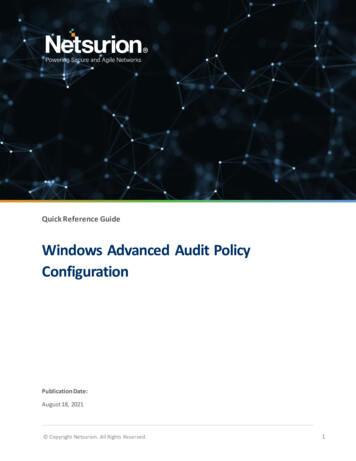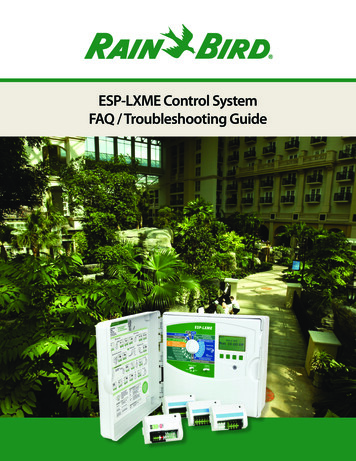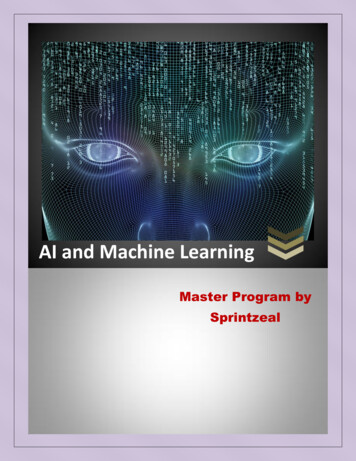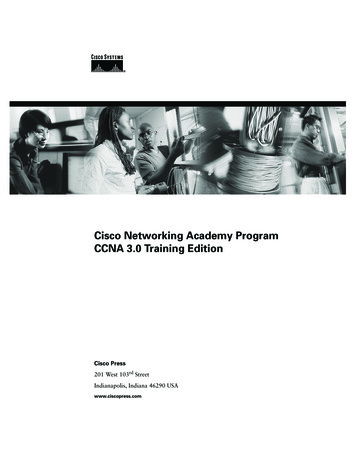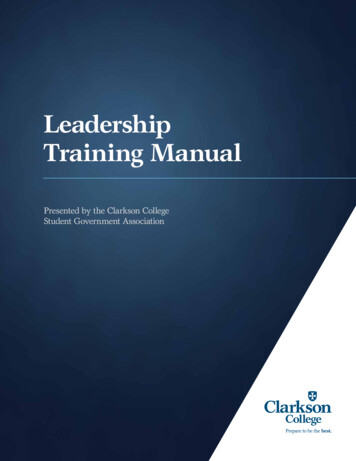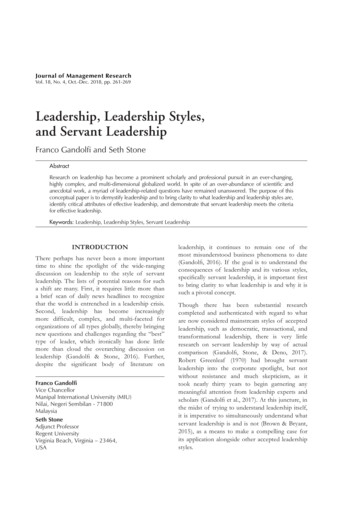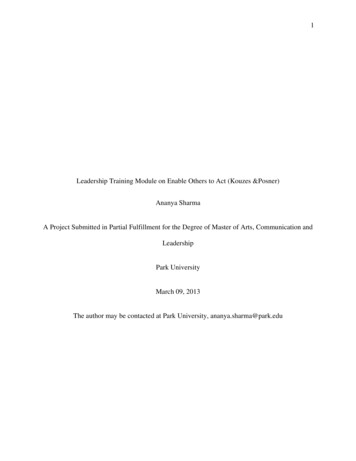
Transcription
1Leadership Training Module on Enable Others to Act (Kouzes &Posner)Ananya SharmaA Project Submitted in Partial Fulfillment for the Degree of Master of Arts, Communication andLeadershipPark UniversityMarch 09, 2013The author may be contacted at Park University, ananya.sharma@park.edu
TRAINING MODULE (ENABLE OTHERS TO ACT)2Workshop DescriptionEveryone has either come in contact with a leader or played the role of a leader.Everyone has also worked with effective leaders and ineffective leaders. And all of us want towork with leaders who can share a vision with us and empower and enable us to meet our goals.One can say that leaders play a crucial role in the success or failure of a task and achievement ofgoals.This training unit is based on one of the five exemplary practices of effective leaders asproposed by Kouzes and Posner. A combination of different training methods (power pointpresentation, group activities, visual clips etc) have been compiled together to communicate thecontent that has been selected after conducting a need analysis. An assessment tool at the end ofthe training measures if the training was well received and well understood by the trainees.
TRAINING MODULE (ENABLE OTHERS TO ACT)Course ObjectivesIdentify leadership behaviors that Enable Others to ActApply the concept of Enabling Others to Act in everyday life3
TRAINING MODULE (ENABLE OTHERS TO ACT)Content OutlineLearning Activities-Leadership Development Worksheet-Enabling with style-Journey to the Center of the EarthPower point Presentation covering underlying concept behind the idea4
TRAINING MODULE (ENABLE OTHERS TO ACT)Behavioral ObjectivesIdentify leadership behaviors that Enable Others to ActApply the concept of Enabling Others to Act in everyday life5
TRAINING MODULE (ENABLE OTHERS TO ACT)6About the TrainerAnanya Sharma will be the leader of the upcoming Leadership workshop on EnablingOthers to Act. Sharma has two years of teaching experience and is currently employed at CernerCorporation as a Delivery Consultant. Her role requires her to be an agent of change and helpothers adopt new technology. She believes that to be able to do her job well as a consultant it isimperative for her to empower her clients and provide them with the tools they need to be able toperform well at their jobs.Keeping this in mind, Sharma has developed this training module to enable consultants toprovide value to their clients by enabling them to act.
TRAINING MODULE (ENABLE OTHERS TO ACT)7Task Analysis for Enable Others to Act- Leadership at WorkRequires the leader to realize that success is a team effort and that collaboration andaccountability play key roles in determining success. Leaders must have faith that their followersare competent and if not, train them and create an environment where they feel skilled andproficient (Kouzes & Posner, 2007):-Honesty and candor-Accessibility and openness-Approving and accepting-Facilitate relationships-Develop cooperative goals and rolesBackground on the Module’s DevelopmentOrganizations can be defined as business concerns that unite in order to reach specificgoal(s). It is a social unit that is structured in a manner that facilitates the attainment of goals asspecified in the organization’s mission statement and vision. Organization structure determinesthe activities undertaken by the organization as well as the roles and responsibilities of themembers. The group of people I will be teaching/training are part of a healthcare IT organizationthat aims at transforming health care by reducing errors and waste and empowering theconsumers (patients) and providers ( physicians, registered nurses, pharmacies, hospitals etc.) ofthe industry. The main goal of the organization is to contribute towards systematic improvementin the way health care is delivered. It aims at changing the way:-People pay for health care, by streamlining electronic payments-People use and share information, by ensuring access to information in real time and
TRAINING MODULE (ENABLE OTHERS TO ACT)-8People think about health, by empowering them to take their health in to their own handsand work proactively towards being healthyAs consultants who work for the organization, associates are agents of changes, who replacepaper with paperless technology, causing much fear and chaos in the way hospitals function now.Needless to say, change meets resistance and associates must be trained in being leaders whofacilitate change without causing panic and making the transition as smooth as possible.Therefore, it is my intention to develop a teaching/training module for incoming associatesby introducing them to one exemplary practice – enable others to act – as proposed by Kouzesand Posner. 95% of the associates will be fresh college graduates who will undergo extensivetraining for 8 weeks prior to being placed in their roles. The training incorporates both technicaland soft skills. It is during the soft skills training week that I will present my training module totrainees.Assessment Measure used to develop the ModuleWe have all worked with a leader or played the part of a leader in our lives. As followers andleaders, we have certain expectations from our leaders and followers respectively. Please take amoment to answers the following questions. Your responses will be kept confidential and will beused as feedback when designing modules for your training program.1. Are you aware of the concept of leadership?YesNo
TRAINING MODULE (ENABLE OTHERS TO ACT)2.9If yes, how and in what capacity?3. What do you know about leadership?4. Can you define leadership?5. What are the characteristics of an effective leader? Please list as many as you can.6. Have you ever been introduced to or heard about the LPI 360ₒ as proposed by Kouzes andPosner?7. If yes, what do you know about the five exemplary practices?8. What would you want to learn about the five exemplary practices (Model the Way,Inspire a Shared Vision, Challenge the Process, Enable Others to Act, Encourage theHeart) as proposed by Kouzes and Posner to improve your leadership style?Assessment ToolName1. Which of the following is not an element of enabling others to act? (1Point)a. foster loyalty and commitmentb. create a climate of trustc. affirm shared valuesd. support norms of reciprocity2. From the examples discussed during the training module, describe how the leader (fromany one scenario) enabled others to act. ( 2 Points)3. List the 6 strategies good leaders use to enable others to act? (6 Points)4. According to Kouzes and Posner, leadership is an observable and learnable set ofpractices: (1Point)a. Trueb. False5. What have you learnt in this training session and how can you apply it to your daily life?(2 Points)
TRAINING MODULE (ENABLE OTHERS TO ACT)10Answer Key1. C2. 3. 6 characteristicsDevelop cooperative relationships with people they work withActively listen to diverse points of viewTreat others with dignity and respectSupport decisions that other people make on their ownGive people freedom in deciding how they want to do their wokEnsure that people grown in their jobs by learning new skills and developing themselves4. A5. –
TRAINING MODULE (ENABLE OTHERS TO ACT)11Learning ActivitiesThe first activity (Learning Activity 1) is a leadership training activity where groups ofthree are tied together and one team member is “mute”, one is “deaf” and the last one is “blind”.The teams have to navigate obstacles and reach the finish line. This activity helps foster a teamspirit, develop interdependence and creates trust among team members.The Enabling with Style (Learning Activity 2) group activity gives trainees theopportunity to empathize with others’ way of doing and highlights the whole brain approach totasks. Trainees choose one out of four styles they would like to describe to their partners and arethen giving opposing guidelines to build their descriptions. The four quadrant model brings toattention the significance of allowing others to choose how they want to work.Leadership Development Worksheets (Learning Activity 3) serve the purpose ofenabling the trainees to conceptualize the leadership practice focus and list related behaviors andactions they will take in order to cultivate the said behavior. Trainees provide a time frame,based on their preference, within which they must implement the behaviors they have identifiedand put them in to practice.By asking trainees to fill out the worksheets, we are enabling them to zero in onbehaviors they want to improve on and giving them the opportunity to reflect on the actions theycan take in their everyday lives that will help them reach their goals.
TRAINING MODULE (ENABLE OTHERS TO ACT)12Power Point PresentationThe power point presentation is to be used more as a guideline for the presenter and thetrainees. It first slide is used to introduce Learning Activity 3, where trainees will work togetheras a team to navigate an obstacle course to reach the finish line. This is followed by a clip fromthe movie Coach Carter, which is the story of a man who undertakes the role of coaching abasketball team and inculcates in the players the value of working as a cohesive unit.At the end of the clip, trainees are asked to discuss Coach Carter’s character and pin pointthe strategies he used to enable his team, keeping the group activity in mind and tying the twotogether to develop an understanding of how effective leaders foster collaboration and buildrelationships.After this activity, the behaviors that have been identified by Kouzes and Posner thatmake a leader effective at enabling others to act are discussed. The training ends with traineesfilling out the leadership development worksheets.
TRAINING MODULE (ENABLE OTHERS TO ACT)13
TRAINING MODULE (ENABLE OTHERS TO ACT)14
TRAINING MODULE (ENABLE OTHERS TO ACT)15
TRAINING MODULE (ENABLE OTHERS TO ACT)16
TRAINING MODULE (ENABLE OTHERS TO ACT)17
TRAINING MODULE (ENABLE OTHERS TO ACT)18
TRAINING MODULE (ENABLE OTHERS TO ACT)19
TRAINING MODULE (ENABLE OTHERS TO ACT)20
TRAINING MODULE (ENABLE OTHERS TO ACT)21
TRAINING MODULE (ENABLE OTHERS TO ACT)22
TRAINING MODULE (ENABLE OTHERS TO ACT)23
TRAINING MODULE (ENABLE OTHERS TO ACT)24
TRAINING MODULE (ENABLE OTHERS TO ACT)25ReferencesHackman, M. Z., & Johnson, C. E. (2004). Leadership: A communication perspective (4th ed.).Long Grove, IL: Waveland Press.Hammond, D., & Nelson, E. (2010). Journey to the center of the earth: An enabling others to actactivity (OBTC Proceedings Page 0018). University of Central MissouriKouzes, J. & Posner, B. (2007).The leadership challenge (4th ed.). San Francisco, CA: Wiley.Kouzes, J. & Posner, B. (2010).The leadership challenge activities book (Ed.). San Francisco,CA: Wiley.Kouzes, J. M., & Posner, B. Z. (2010). The leadership practices inventory: Facilitator’s guide(3rd ed.). San Francisco, CA: Wiley.Kouzes, J. M., & Posner, B. Z. (2010). The leadership practices inventory: Leadershipdevelopment planner (3rd ed.). San Francisco, CA: Wiley.Kouzes, J. M., & Posner, B. Z. (2000-2009). The leadership challenge. Wiley. Retrieved ction/id-131011.htmlKouzes, J. M., & Posner, B. Z. (2010). The truth about leadership: The no-fads, heart of thematter facts you need to know. Josey-Bass. Retrieved /TruthAboutLeadership BBS.pdf
7. If yes, what do you know about the five exemplary practices? 8. What would you want to learn about the five exemplary practices (Model the Way, Inspire a Shared Vision, Challenge the Process, Enable Others to Act, Encourage the Heart) as proposed by Kouzes and Posner to improve your leadership style? Assessment Tool
